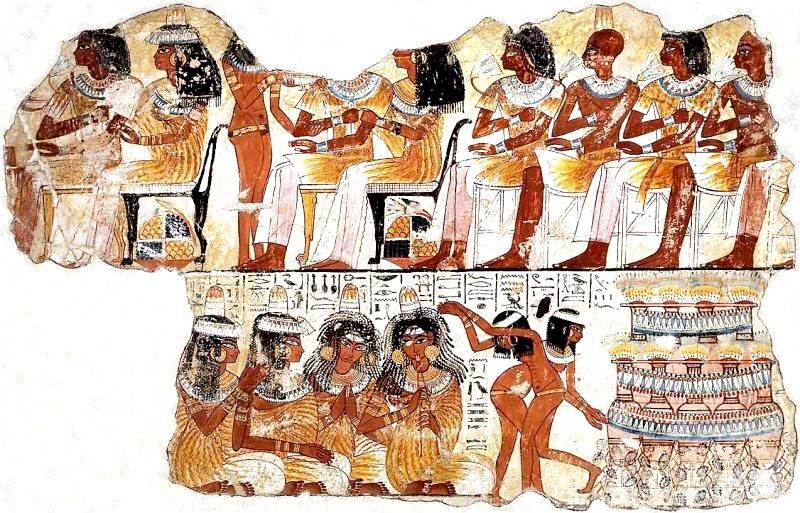
Ancient Egyptian Dance

Figure 1.-- This is a fragment of a wall painting in the tomb of Nabamun, in Thebes (18th dynasty). We can clearly see that nudity was the usual condition of dancers and generally slave women. There are two strips. We do not know how the strips were related. In the top strip we can see the free women clothed with a naked slave woman serving them. Surely the image shows a banquet as we can see in this other painting in the same tomb. It could be a party or a funerary banquet. Some archeologists think that the cones on the heads were fragrances. The elegance and grace of Eguptian dancers is beautifully depicted in the bottom strip. The nudity of the dancers may not mean that they were slaves, but rather to allow freedom of movement, in much the same way that balet dancers wear leotards. Erotic appeal is of course another possibility which can not be dimissed. Notice the weighted plaits of the dancers. We note that musicians are commonly, but not always clothed. Notice the womrn with them. They do not seem to be an audience and are all clothed. They seem be clapping and one seems to be playing a recorder-like instrument.
|
|
Both music and dance were a potentially lucrative undertaking pursued by both men and women, but based on the imagery found in Egyptian tombs, both were more commonly pursued by women. It was a rare area in hich women could earn money. This could be done in various ways. They could be employed by royalty or priests as wll as nobles with large estates. Or they could work freelance, performing at festivals or at parties by well-to-do hosts. The Egyptians enjoyed music and dance. The two were often interconnected. The Egyptians enjoyed singing, playing musical instruments, and dancing during their leisure time. Humble farmers and workers danced to give thanks for good harvests. The wealthy enjoyed all-female song and dance troupes were as after dinner entertainment. A talented woman could choose dancing as asocially cceotable career. This became the case early in Egyoptian history. The names of such performers are for the most part lost to history. The Old Kingdom female performing duo of Hekenu and Iti were so spectcular that they were commemorated in the tomb of Nikaure, an accountant. While an anomally, it suggests the popularity of dancing in ancient Egypt. And while names are not mentioned, we commonly see dancrs depicted in Egyptian tombs. Dancing impages first appear as part of religious ritual and then in purely secular settings. The Dancer of the Muu was performed at funerals by male dancers wearing tall head-dresses made of reeds. The Sed-festival, the Opet Festival, Processions of the Sacred Barques, and other festivals, all included rituals and celebrations which included dancers. A chant found enscribed on the Temple of Hathor at Dendera reads, "The King comes to dance, he comes to sing. Sovereign lady, see how he dances, Wife of Horus, see how he leaps." We know a great deal about the dances performed. The primary sourcec come from tomb pintings and reliefs. These images show skillful ans attractive dancers running, swaying, jumping, pirouetting, and sinuously bending. Much of what we see in ballet and modern fance. They are often shown with tambourines or with other playing nusical insruments. We see dancers variously costumned. Weighted hair-plaits swing wideky, adding to the motion of their bodies. Some were virtually naked with only belt girdles or other adornments. Others wore dresses, including diaphanous robes. The naked dancers may be an indication of slavery. The lack of clothing also enabled the dancers to move freely. Of course in Egypt's hot climate, the absence of clothing or scantty clothing was not uncommon. Scholars have studied Egyptian dancing. The depictions suggest considerable skill and grace as well as acrobatic moves. [Strouhal] This would of course required training, perhaps beginning in childhood. Nothing is known, however, about how these dancers were selected and trained. There are no depictions of children being schoolen dance.
Sources
Strouhal, Eugen. Life in Ancient Egypt.
HBC

Navigate the Historic Boys' Clothing Web Site:
[Return to the Main ancient Egyptian page]
[Return to the Main dance page]
[Introduction]
[Activities]
[Art chronologies]
[Biographies]
[Countries]
[Photography]
[Style Index]
[Bibliographies]
[Contributions]
[FAQs]
[Glossaries]
[Images]
[Links]
[Registration]
[Tools]
[Boys' Clothing Home]
Created: 9:28 AM 1/16/2013
Last updated: 9:28 AM 1/16/2013



